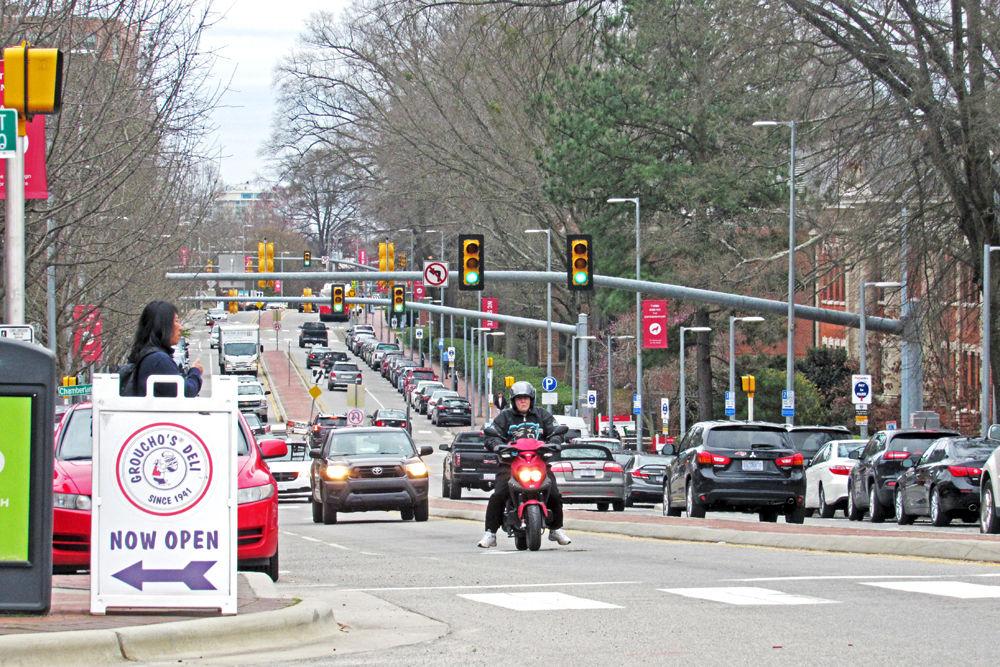With the growth for Hillsborough Street in terms of retail stores, increase of off-campus student housing complexes and the addition of roundabouts, city officials are confident that Hillsborough Street can handle an increase in traffic.
Eric Lamb, transportation planning manager with the Raleigh Department of Transportation, said the Hillsborough Street Renewal Project was the solution to the street’s growing problem of pedestrian safety in the 1990s. Lamb outlined the project and addressed potential concerns that more apartments would create more traffic on the street.
“Back in the late 1990s, Hillsborough Street developed a reputation for being particularly hazardous for pedestrians,” Lamb said. “At one point it had the highest pedestrian crash rate for any major street in North Carolina.”
The goal of the project was to make Hillsborough Street a destination for residents and less of the four-lane thoroughfare that it had become. To do this, Hillsborough Street would have to become pro-pedestrian and reduce the street’s footprint while adding roundabouts to keep traffic moving.
Phases one and two of the renewal project have been completed as of fall 2018. These phases added roundabouts at Pullen Road, Brooks Avenue, Dixie Trail, and the intersection of Rosemary Street and Shepherd Street. The phases also added enhanced sidewalks, raised medians, bike lanes, on-street parking and underground utilities.
Lamb said the two phases were completed at a combined cost of around $30 million.
“One of the things we’ve noticed now that phase two is complete is that traffic moves a lot better through the corridor in general,” Lamb said.
The use of vertical mixed-use development, such as apartments on top of other stores and restaurants, minimizes the traffic impact on the street, according to Lamb. The apartment residents of Hillsborough Street have access to several amenities without need for a car.
However, the improvements do not make Hillsborough Street immune to congestion, Lamb explained.
“It certainly does get congested at certain parts of the day,” Lamb said. “It’s not necessarily a bad thing when you look at what we were aiming to do, which was to improve pedestrian safety and to improve the economic vitality of Hillsborough Street. The crash rate is way, way down from what it used to be. From an economic development standpoint, there has been millions of dollars’ worth of new investment in the corridor.”
Mike Kennon, assistant director for planning and operations at NCSU Transportation, worked for the city of Raleigh during phase one and joined NC State staff during phase two.
Kennon said that there has been little impact to NC State as a result of the construction.
“There’s now a restriction at Dan Allen and Hillsborough — it’s now a left in and right out — but I really think that has been minimal as far as impact to us,” Kennon said. “It has had minimal impact to Wolfline because we have Founders Drive, which is a parallel transit way.”
Kennon added that the additions have changed the Hillsborough Street environment for the NC State and Raleigh communities.
“I think the road now has more of an urban character and feel, which is appropriate for what’s going on on both sides of the road,” Kennon said.
According to Lamb, future phases look to add a roundabout at Hillsborough Street and Gorman Street, redevelop the road from Hillsborough Street and Gorman Street to Interstate 440 and improve the roads from Oberlin Road to Morgan Street.
With the recent additions and future improvements, Lamb is excited for the future of Hillsborough Street.
“I think we’re seeing Hillsborough Street grow up,” Lamb said. “It’s going to continue to evolve. Everything is trending really positively, and I think everything is moving in the right direction.”








